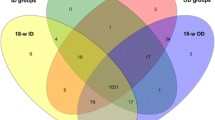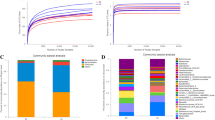Abstract
Rearing systems play an important role in animal welfare, health and the composition of the gut microbiome. Therefore, the purpose of this study was to investigate the effects of different rearing systems on the composition and function of cecal microbiota in chickens. The 120-day-old Lohmann hens of cage rearing systems (CRS) and free-range systems (FRS) were studied. The cecal bacterial populations of hens were surveyed by high-throughput sequencing (HTS) of the bacterial 16S rRNA hypervariable region V3–V4 combined with metagenomic sequencing analysis. The 16S rRNA sequencing analysis showed that the cecal microbiota differed between the FRS and CRS. The three most abundant bacteria phyla in the two systems were the Bacteroidetes (> 48%), Firmicutes (> 37%), and Proteobacteria (> 6%), the Deferribacteres (> 2.4%) were found in FRS and almost absent in CRS (< 0.01%). The three most abundant genera were the Bacteroides, Rikenellaceae_RC9, and Faecalibacterium, and we found relative abundance of the Parabacteroides (P < 0.05), Prevotellaceae_Ga6A1 (P < 0.01), unclassified Proteobacteria (P < 0.05), and unclassified Spirochaetaceae (P < 0.01) was greater in FRS, whereas abundance of Faecalibacterium, Ruminococcaceae, and Helicobacter was greater in CRS (P < 0.05). Functional gene classification of metagenomic sequencing suggested that energy production and conversion, carbohydrate transport and metabolism, as well as amino acid transport and metabolism were significantly more abundant in FRS, and we identified a range of antibiotic resistance categories in gut microbes of hens reared under both systems. We confirmed differences in microbe gut composition and function in hens reared using two contrasting systems, and ARGs were also identified in the microbiota of these hens. This work has produced new data for laying hens in different production systems and increased the understanding of intestinal microorganisms in laying hens.






Similar content being viewed by others
Explore related subjects
Discover the latest articles and news from researchers in related subjects, suggested using machine learning.References
Adil S, Magray SN (2012) Impact and manipulation of gut microflora in poultry: a review. J Anim Vet Adv 11(6):873–877. https://doi.org/10.3923/javaa.2012.873.877
Altschul SF, Madden TL, Schaffer AA, Zhang J, Zhang Z, Miller W, Lipman DJ (1997) Gapped BLAST and PSI-BLAST: a new generation of protein database search programs. Nucleic Acids Res 25(17):3389–3402. https://doi.org/10.1093/nar/25.17.3389
Barnes EM (1972) The avian intestinal flora with particular reference to the possible ecological significance of the cecal anaerobic bacteria. Am J Clin Nutr 25(12):1475–1479. https://doi.org/10.1093/ajcn/25.12.1475
Berry D (2016) The emerging view of Firmicutes as key fibre degraders in the human gut. Environ Microbiol 18(7):2081–2083. https://doi.org/10.1111/1462-2920.13225
Best AA, Porter AL, Fraley SM, Fraley GS (2017) Characterization of gut microbiome dynamics in developing pekin ducks and impact of management system. Front Microbiol. https://doi.org/10.3389/fmicb.2016.02125
Cao GT, Zeng XF, Chen AG, Zhou L, Zhang L, Xiao YP, Yang CM (2013) Effects of a probiotic, Enterococcus faecium, on growth performance, intestinal morphology, immune response, and cecal microflora in broiler chickens challenged with Escherichia coli K88. Poult Sci 92(11):2949–2955. https://doi.org/10.3382/ps.2013-03366
Chang Q, Luan Y, Sun F (2011) Variance adjusted weighted UniFrac: a powerful beta diversity measure for comparing communities based on phylogeny. BMC Bioinform. https://doi.org/10.1186/1471-2105-12-118
Clavijo V, Vives Florez MJ (2018) Non-invited review the gastrointestinal microbiome and its association with the control of pathogens in broiler chicken production: a review. Poult Sci 97(3):1006–1021. https://doi.org/10.3382/ps/pex359
Cui Y, Wang Q, Liu S, Sun R, Zhou Y, Li Y (2017) Age-Related variations in intestinal microflora of free-range and caged hens. Front Microbiol. https://doi.org/10.3389/fmicb.2017.01310
DeSantis TZ, Hugenholtz P, Larsen N, Rojas M, Brodie EL, Keller K, Huber T, Dalevi D, Hu P, Andersen GL (2006) Greengenes, a chimera-checked 16S rRNA gene database and workbench compatible with ARB. Appl Environ Microbiol 72(7):5069–5072. https://doi.org/10.1128/aem.03006-05
Edgar RC (2010) Search and clustering orders of magnitude faster than BLAST. Bioinformatics 26(19):2460–2461. https://doi.org/10.1093/bioinformatics/btq461
Eren AM, Vineis JH, Morrison HG, Sogin ML (2013) a filtering method to generate high quality short reads using illumina paired-end technology. PLoS One. https://doi.org/10.1371/journal.pone.0066643
Faith DP, Baker AM (2006) Phylogenetic diversity (PD) and biodiversity conservation: some bioinformatics challenges. Evol Bioinform 2:121–128
Fu L, Niu B, Zhu Z, Wu S, Li W (2012) CD-HIT: accelerated for clustering the next-generation sequencing data. Bioinformatics 28(23):3150–3152. https://doi.org/10.1093/bioinformatics/bts565
Han GG, Kim EB, Lee J, Lee J-Y, Jin G, Park J, Huh C-S, Kwon I-K, Kil DY, Choi Y-J, Kong C (2016) Relationship between the microbiota in different sections of the gastrointestinal tract, and the body weight of broiler chickens. Springerplus. https://doi.org/10.1186/s40064-016-2604-8
Hold GL, Pryde SE, Russell VJ, Furrie E, Flint HJ (2002) Assessment of microbial diversity in human colonic samples by 16S rDNA sequence analysis. FEMS Microbiol Ecol 39(1):33–39. https://doi.org/10.1111/j.1574-6941.2002.tb00904.x
Jensen LJ, Julien P, Kuhn M, von Mering C, Muller J, Doerks T, Bork P (2008) eggNOG: automated construction and annotation of orthologous groups of genes. Nucleic Acids Res 36:D250–D254. https://doi.org/10.1093/nar/gkm796
Li R, Li Y, Kristiansen K, Wang J (2008) SOAP: short oligonucleotide alignment program. Bioinformatics 24(5):713–714. https://doi.org/10.1093/bioinformatics/btn025
Li M, Zhou M, Adamowicz E, Basarab JA, Guan LL (2012) Characterization of bovine ruminal epithelial bacterial communities using 16S rRNA sequencing, PCR-DGGE, and qRT-PCR analysis. Vet Microbiol 155(1):72–80. https://doi.org/10.1016/j.vetmic.2011.08.007
Mancabelli L, Ferrario C, Milani C, Mangifesta M, Turroni F, Duranti S, Lugli GA, Viappiani A, Ossiprandi MC, van Sinderen D, Ventura M (2016) Insights into the biodiversity of the gut microbiota of broiler chickens. Environ Microbiol 18(12):4727–4738. https://doi.org/10.1111/1462-2920.13363
McDonald D, Price MN, Goodrich J, Nawrocki EP, DeSantis TZ, Probst A, Andersen GL, Knight R, Hugenholtz P (2012) An improved Green genes taxonomy with explicit ranks for ecological and evolutionary analyses of bacteria and archaea. ISME J 6(3):610–618. https://doi.org/10.1038/ismej.2011.139
Neufeld JD, Mohn WW (2005) Unexpectedly high bacterial diversity in arctic tundra relative to boreal forest soils, revealed by serial analysis of ribosomal sequence tags. Appl Environ Microbiol 71(10):5710–5718. https://doi.org/10.1128/aem.71.10.5710-5718.2005
Noguchi H, Park J, Takagi T (2006) MetaGene: prokaryotic gene finding from environmental genome shotgun sequences. Nucleic Acids Res 34(19):5623–5630. https://doi.org/10.1093/nar/gkl723
Pan D, Yu Z (2014) Intestinal microbiome of poultry and its interaction with host and diet. Gut Microbes 5(1):108–119. https://doi.org/10.4161/gmic.26945
Reid NM, Addison SL, Macdonald LJ, Lloyd-Jones G (2011) Biodiversity of active and inactive bacteria in the gut flora of wood-feeding huhu beetle larvae (Prionoplus reticularis). Appl Environ Microbiol 77(19):7000–7006. https://doi.org/10.1128/aem.05609-11
Scanes CG, Braun (2013) Avian metabolism: its control and evolution. Front Biol 8(2):134–159. https://doi.org/10.1007/s11515-012-1206-2
Siegerstetter S-C, Schmitz-Esser S, Magowan E, Wetzels SU, Zebeli Q, Lawlor PG, O’Connell NE, Metzler-Zebeli BU (2017) Intestinal microbiota profiles associated with low and high residual feed intake in chickens across two geographical locations. PLoS One. https://doi.org/10.1371/journal.pone.0187766
Stanley D, Geier MS, Denman SE, Haring VR, Crowley TM, Hughes RJ, Moore RJ (2013a) Identification of chicken intestinal microbiota correlated with the efficiency of energy extraction from feed. Vet Microbiol 164(1–2):85–92. https://doi.org/10.1016/j.vetmic.2013.01.030
Stanley D, Geier MS, Hughes RJ, Denman SE, Moore RJ (2013b) Highly variable microbiota development in the chicken gastrointestinal tract. PLoS One. https://doi.org/10.1371/journal.pone.0084290
Stanley D, Hughes RJ, Geier MS, Moore RJ (2016) Bacteria within the gastrointestinal tract microbiota correlated with improved growth and feed conversion: challenges presented for the identification of performance enhancing probiotic bacteria. Front Microbiol. https://doi.org/10.3389/fmicb.2016.00187
Torok VA, Hughes RJ, Mikkelsen LL, Perez-Maldonado R, Balding K, MacAlpine R, Percy NJ, Ophel-Keller K (2011) Identification and characterization of potential performance-related gut microbiotas in broiler chickens across various feeding trials. Appl Environ Microbiol 77(17):5868–5878. https://doi.org/10.1128/aem.00165-11
Ubeda C, Djukovic A, Isaac S (2017) Roles of the intestinal microbiota in pathogen protection. Clin Transl Immunol. https://doi.org/10.1038/cti.2017.2
Van den Abbeele P, Grootaert C, Marzorati M, Possemiers S, Verstraete W, Gerard P, Rabot S, Bruneau A, El Aidy S, Derrien M, Zoetendal E, Kleerebezem M, Smidt H, Van de Wiele T (2010) Microbial community development in a dynamic gut model is reproducible, colon region specific, and selective for bacteroidetes and clostridium cluster IX. Appl Environ Microbiol 76(15):5237–5246. https://doi.org/10.1128/aem.00759-10
Waite DW, Taylor MW (2014) Characterizing the avian gut microbiota: membership, driving influences, and potential function. Front Microbiol. https://doi.org/10.3389/fmicb.2014.00223
Waite DW, Taylor MW (2015) Exploring the avian gut microbiota: current trends and future directions. Front Microbiol. https://doi.org/10.3389/fmicb.2015.00673
Wang L, Lilburn M, Yu Z (2016a) Intestinal microbiota of broiler chickens as affected by litter management regimens. Front Microbiol. https://doi.org/10.3389/fmicb.2016.00593
Wang W, Cao J, Yang F, Wang X, Zheng S, Sharshov K, Li L (2016b) High-throughput sequencing reveals the core gut microbiome of bar-headed goose (Anser indicus) in different wintering areas in tibet. Microbiol Open 5(2):287–295. https://doi.org/10.1002/mbo3.327
Wei S, Morrison M, Yu Z (2013) Bacterial census of poultry intestinal microbiome. Poult Sci 92(3):671–683. https://doi.org/10.3382/ps.2012-02822
Wright GD (2007) The antibiotic resistome: the nexus of chemical and genetic diversity. Nat Rev Microbiol 5(3):175–186. https://doi.org/10.1038/nrmicro1614
Xie C, Mao X, Huang J, Ding Y, Wu J, Dong S, Kong L, Gao G, Li C-Y, Wei L (2011) KOBAS 2.0: a web server for annotation and identification of enriched pathways and diseases. Nucleic Acids Res 39:W316–W322. https://doi.org/10.1093/nar/gkr483
Yeoman CJ, Chia N, Jeraldo P, Sipos M, Goldenfeld ND, White BA (2012) The microbiome of the chicken gastrointestinal tract. Anim Health Res Rev 13(1):89–99. https://doi.org/10.1017/s1466252312000138
Zhang B, Lv Z, Li Z, Wang W, Li G, Guo Y (2018) Dietary l-arginine supplementation alleviates the intestinal injury and modulates the gut microbiota in broiler chickens challenged by Clostridium perfringens. Front Microbiol. https://doi.org/10.3389/fmicb.2018.01716
Zhou X, Jiang X, Yang C, Ma B, Lei C, Xu C, Zhang A, Yang X, Xiong Q, Zhang P, Men S, Xiang R, Wang H (2016) Cecal microbiota of tibetan chickens from five geographic regions were determined by 16S rRNA sequencing. Microbiol Open 5(5):753–762. https://doi.org/10.1002/mbo3.367
Acknowledgements
We thank the National Science Foundation of China (Grant no. 31772707) for supporting the high-throughput sequencing. The collection of the experimental samples was supported by the Integration and Demonstration of Quality and Safety Control Technology for Green Ecological Livestock and Poultry Products Industry Chain (Grant no. 1604a0702033) and the Animal Food Quality and Safety Control, Anhui Province 115 Industry Innovation Team.
Author information
Authors and Affiliations
Contributions
KQ and SL conceived and designed the experiments; SS, ZQ, and BG performed the experiments; SS, BC, YS, and XS analyzed the data; SS and JT contributed reagents/materials/Únalysis tools; SS, ZQ, and BG wrote the paper. All authors critically read and contributed to the manuscript and approved the final version. All authors critically read and contributed to the manuscript and approved the final version.
Corresponding author
Ethics declarations
Conflict of interest
The authors declare that they have no conflicts of interest.
Ethics approval and consent to participate
This study was performed in accordance with the Chinese Laboratory Animal Administration Act of 1988. Before the experiments, the research protocol was reviewed and approved by the Research Ethics Committee of Anhui Agricultural University. Permission was obtained from all managers of the chicken farms studied before the samples were collected.
Electronic supplementary material
Below is the link to the electronic supplementary material.
Rights and permissions
About this article
Cite this article
Shi, S., Qi, Z., Gu, B. et al. Analysis of high-throughput sequencing for cecal microbiota diversity and function in hens under different rearing systems. 3 Biotech 9, 438 (2019). https://doi.org/10.1007/s13205-019-1970-7
Received:
Accepted:
Published:
DOI: https://doi.org/10.1007/s13205-019-1970-7




